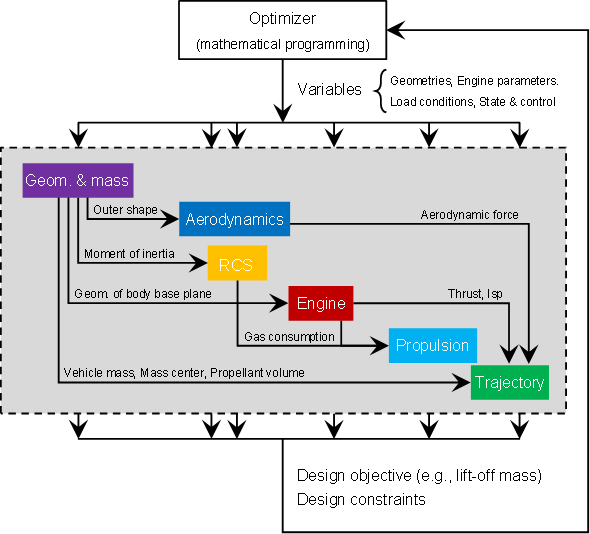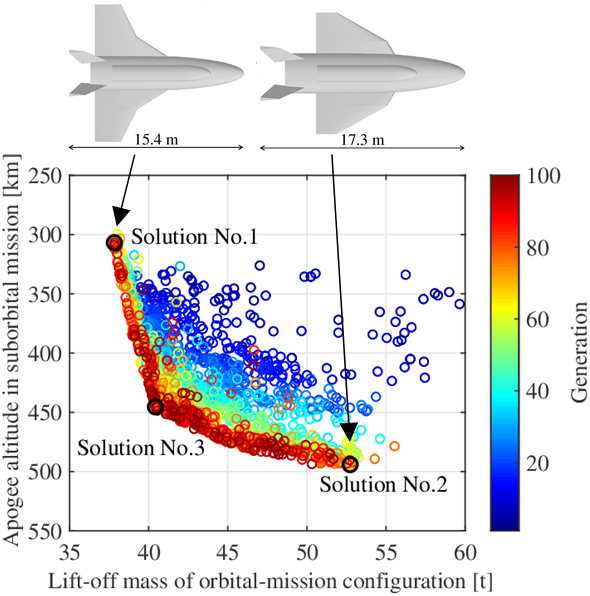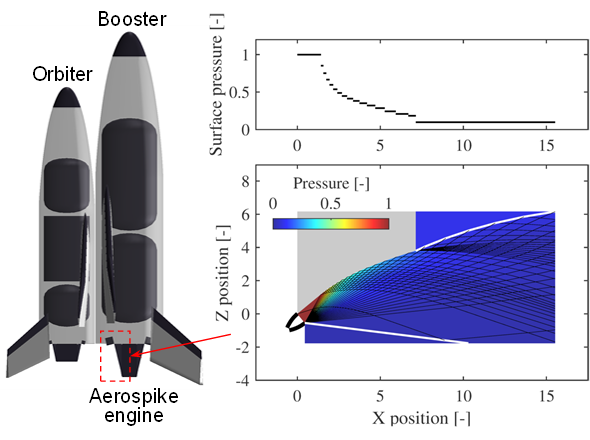System Optimization
Some research subjects on system optimization, or MDO (Multidisciplinary Design Optimization), are explained below.
 Multidisciplinary design optimization of winged space transportation systems via the augmented trajectory optimization method based on mathematical programming is computationally efficient. In order to facilitate the industrial application of this methodology, we have conducted several researches as follows. 1) Implementation of detailed analysis models of propulsion gas tank sizing, RCS (Reaction Control System) operation, control surface angular rate calculation, and so on. 2) Development of an automatic method to generate initial guess for mathematical programming. 3) Development of a method to alleviate control chattering.
Multidisciplinary design optimization of winged space transportation systems via the augmented trajectory optimization method based on mathematical programming is computationally efficient. In order to facilitate the industrial application of this methodology, we have conducted several researches as follows. 1) Implementation of detailed analysis models of propulsion gas tank sizing, RCS (Reaction Control System) operation, control surface angular rate calculation, and so on. 2) Development of an automatic method to generate initial guess for mathematical programming. 3) Development of a method to alleviate control chattering.
 Whereas mathematical programming methods are computationally efficient, they cannot solve multi-objective optimization problems directly and are likely to give merely local optimal solutions. Therefore, we have developed a novel multidisciplinary design optimization framework by combining a multi-objective evolutionary algorithm and a mathematical programming method. This framework makes it possible, for example, to design a multi-purpose vehicle while considering a tradeoff relation between missions by optimizing vehicle design and multiple trajectories simultaneously. In addition, its application to the system optimization considering the influence of uncertainties on trajectory feasibilities is also expected.
Whereas mathematical programming methods are computationally efficient, they cannot solve multi-objective optimization problems directly and are likely to give merely local optimal solutions. Therefore, we have developed a novel multidisciplinary design optimization framework by combining a multi-objective evolutionary algorithm and a mathematical programming method. This framework makes it possible, for example, to design a multi-purpose vehicle while considering a tradeoff relation between missions by optimizing vehicle design and multiple trajectories simultaneously. In addition, its application to the system optimization considering the influence of uncertainties on trajectory feasibilities is also expected.
 Rocket engines with altitude compensating nozzles (e.g., aerospike engines) achieve high performance over a wide range of operating altitudes, and they can be a key technology for realizing efficient reusable launch vehicles. However, system design of the vehicle with such engines is a challenging task, since the performance of the engine depends on flight conditions in a complicated manner. We have studied 1) a simplified design/analysis method of aerospike engines and 2) its implementation into multidisciplinary design optimization of launch vehicles by using surrogate modeling techniques.
Rocket engines with altitude compensating nozzles (e.g., aerospike engines) achieve high performance over a wide range of operating altitudes, and they can be a key technology for realizing efficient reusable launch vehicles. However, system design of the vehicle with such engines is a challenging task, since the performance of the engine depends on flight conditions in a complicated manner. We have studied 1) a simplified design/analysis method of aerospike engines and 2) its implementation into multidisciplinary design optimization of launch vehicles by using surrogate modeling techniques.

